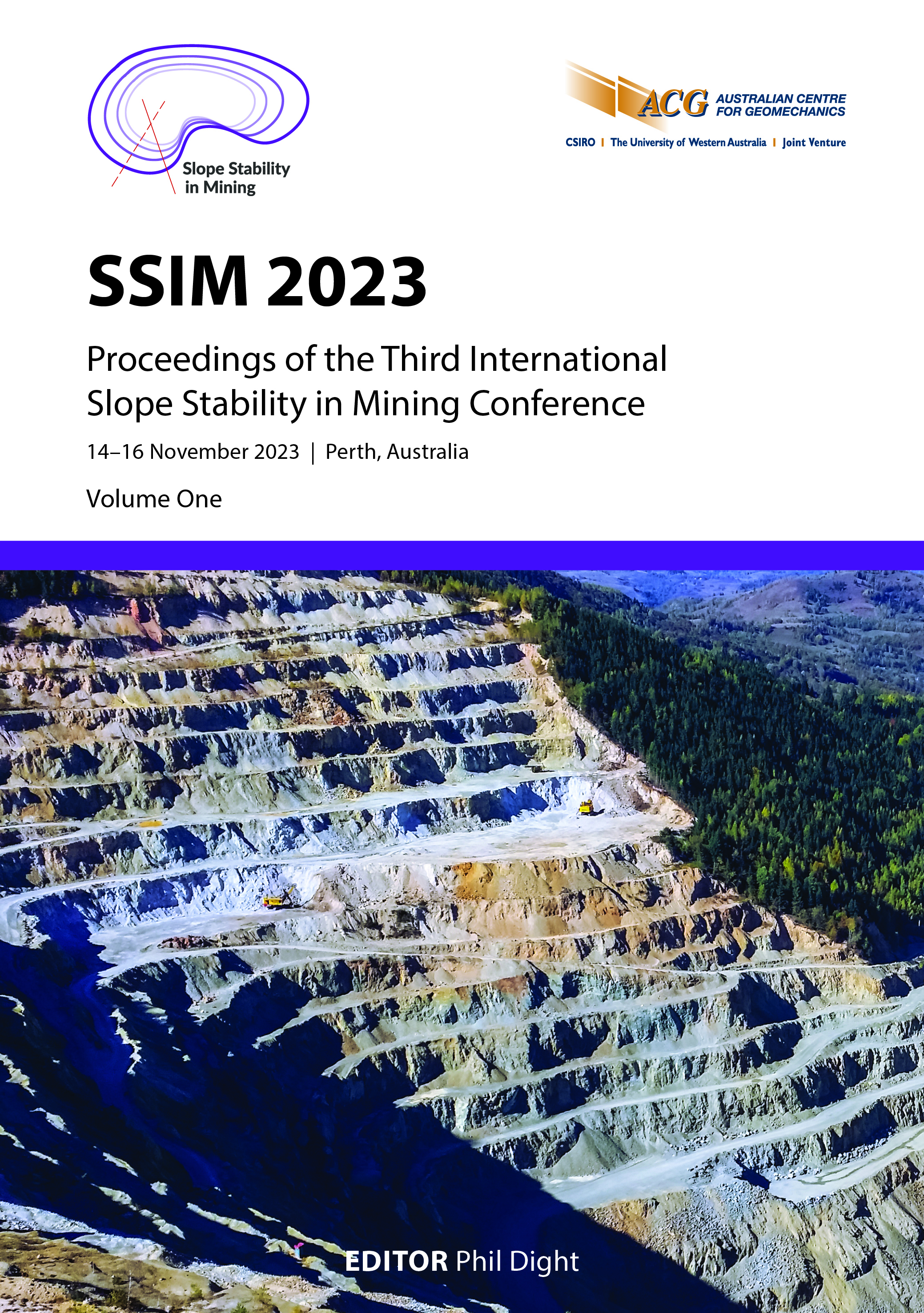Using observations and measurements to establish a relation between modelled movement and Probability of Failure in a large open pit

|
Authors: Levkovitch, V; Flatten, A; Bushkov, V; Selivanov, D; Beck, D |
DOI https://doi.org/10.36487/ACG_repo/2335_48
Cite As:
Levkovitch, V, Flatten, A, Bushkov, V, Selivanov, D & Beck, D 2023, 'Using observations and measurements to establish a relation between modelled movement and Probability of Failure in a large open pit', in PM Dight (ed.), SSIM 2023: Third International Slope Stability in Mining Conference, Australian Centre for Geomechanics, Perth, pp. 707-720, https://doi.org/10.36487/ACG_repo/2335_48
Abstract:
In late 2021, the potential to extend a very large open pit was investigated. The mine has a high-resolution structural and hydrogeological model, permitting construction of a large-strain, discontinuum, closely coupled hydromechanical finite element model with a much better than inter-ramp scale representative elementary volume. In models of this type, the hydrogeological parameters and constitutive model are also non-linear, so that conductivity and the Biot coefficient are expressed as functions of the modelled plastic strain tensor. Additionally, because extreme seasonal variations occur in surface water flows, the models included simulation of the flow of near-surface water and a novel method for capturing the inflow of this water into the dilated rock mass, joints and faults, thus permitting estimation of active water pressure. Active water pressure in the damaged and dilated rock mass and rock mass defects is a major driver of instability in slopes, but it is not often simulated, especially in models of this scale (30 pit stages, over 100M degrees of freedom). The addition of this mechanism for water-driven instability and the high-resolution model setup permitted very close calibration of modelled and measured movements, enabled measurement of hydraulic head and failures using many years of data, and facilitated a statistical analysis of the correlation of failure and modelled movement and strain. This was undertaken using a cell evaluation method (CEM; Beck & Brady 2001), resulting in a true probability function using model outputs with an estimate of error and resolution. The CEM has previously been used to compute the relation between seismic event probability and stress and energy criteria for underground mines, but this is the first known use of its application for an open pit. The project resulted in a comprehensive validation of the model for the mine, a useable probabilistic criterion for slope failures ranging from small to medium, and a hypothesis ranging from the extrapolation of early slope stability data to the prediction of larger failures. There are also lessons regarding the necessary resolution of hydromechanical assumptions and inputs for high-quality prediction of slope instability, particularly the need to capture the influence of rock mass and rock defect dilation and degradation on flow and pressure.
Keywords: feasibility study, large open pit slope, hydromechanical coupling, non-linear model, open pit stage, Probability of Failure, active pressure, Factor of Safety, slope failure, pore pressure, near-surface hydrology, LR4, freeze thaw, melt water
References:
Beck, DA & Brady, BHG 2001, ‘A numerical method for engineering management of induced seismic risk in hard rock mining’, Proceedings of the 5th International Symposium on Rockbursts and Seismicity in Mines, Southern African Institute of Mining and Metallurgy, Johannesburg.
Beck, DA, Lilley, CR, Reusch, F, Levkovitch, V, Putzar, G & Flatten, A 2013, ‘A preliminary, calibrated scheme for estimating rock mass properties for non-linear, discontinuum models’, Sinorock 2013: Rock Characterisation, Modelling and Engineering Design Methods, Taylor & Francis Group, London, pp. 183–188.
Flatten, A & Beck, DA 2015, ‘Applications of hydromechanically coupled 3D mine and reservoir scale, discontinuous, strainsoftening dilatant models with damage’, Proceedings of the 49th US Rock Mechanics and Geomechanics Symposium, American Rock Mechanics Association, Alexandria.
Flatten, A, Reusch, F & Beck, DA 2016, ‘The application of hydro-mechanical mine-scale modelling for large block caving operations’, Proceedings of the 7th International Conference & Exhibition on Mass Mining – MassMin 2016, Australasian Institute of Mining and Metallurgy, Melbourne.
Levkovitch, V, Reusch, F & Beck, D 2010, ‘Application of a non-linear confinement sensitive constitutive model to mine scale simulations subject to varying levels of confining stress’, in J Zhao, V Labiouse, J-P Dudt & J-F Mathier (eds), Rock Mechanics in Civil and Environmental Engineering, CRC Press, Boca Raton, pp. 161–164.
Mahyari, AT & Selvadurai, APS 1998, ‘Enhanced consolidation in brittle geomaterials susceptible to damage’, Mechanics of Cohesive-frictional Materials, Wiley, Hoboken.
Piteau Associates 2022, hydrogeological report for Polyus.
Rutqvist, J, Börgesson, L, Chijimatsu, M, Hernelind, J, Kobayashi, A & Nguyen, S 2009, ‘Modeling of damage, permeability changes and pressure responses during excavation of the TSX tunnel in granitic rock at URL, Canada’, Environmental Geology, vol. 57, pp. 1263–1274,
Shirazi, A & Selvadurai, APS 2005, ‘Lateral loading of a rigid rock socket embedded in a damage-susceptible poroelastic solid’, International Journal of Geomechanics, vol. 5, no. 4,
Suvorova, AP & Selvadurai, APS 2019, ‘The Biot coefficient for an elasto-plastic material’, International Journal of Engineering Science, vol. 145,
© Copyright 2026, Australian Centre for Geomechanics (ACG), The University of Western Australia. All rights reserved.
View copyright/legal information
Please direct any queries or error reports to repository-acg@uwa.edu.au
View copyright/legal information
Please direct any queries or error reports to repository-acg@uwa.edu.au

